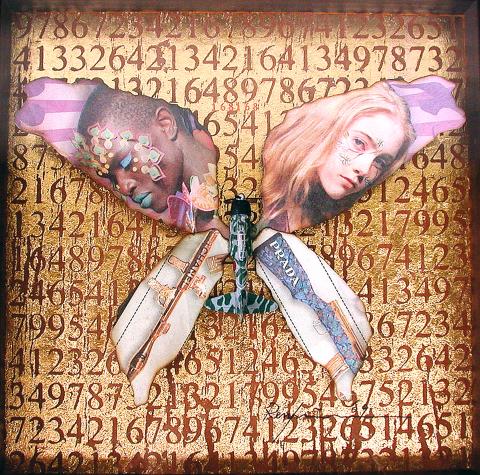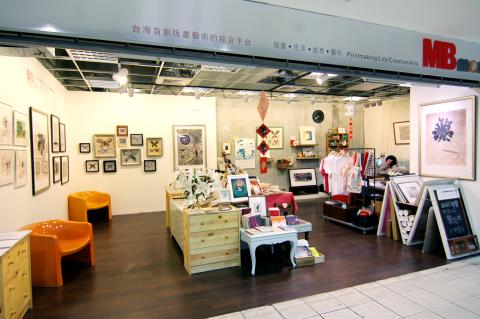Now celebrating its first anniversary, MBmore (岩筆模) is one of the few spaces dedicated to selling work by Taiwanese print artists.
“MBmore gives artists a platform and people who aren’t familiar with printmaking a chance to learn more about it,” manager Su Yu-ting (蘇鈺婷) told the Taipei Times.
Su’s own highly detailed etchings are sold in the store, which is located in Zhongshan Metro Mall (中山地下街) next to an exhibition space run by the Museum of Contemporary Art (MOCA, 台北當代藝術館). The address is Zhongshan Metro Mall B39 (台北捷運中山地下街B39), near exit R9 between Zhongshan (中山) and Shuanglian (雙連) MRT stations.

Photo Courtesy of Lin Ren-hsin
MBmore carries work by more than 40 individual artists and studios. Printmaking techniques represented include aquatint, woodcuts, silk-screening and letterpress. Art styles and subject matter are just as diverse. Chen Hua-jun’s (陳華俊) darkly humorous etchings are inspired by manga, while the lush and colorful images created by Huang Chun-yuan (黃椿元) use motifs from Japanese and Taiwanese culture and art.
Other items for sale include greeting cards, silk-screened canvas totes and T-shirts by MuSe Handmade and In Blooom (印花樂), and individual lead type from Ri Xing Typography (日星鑄字行).
Founder Lin Ren-hsin (林仁信) wants to cultivate an audience for his fellow print artists. Lin, who has exhibited in France, Japan and the US, says printmaking is underappreciated in Taiwan, where it is often viewed as just a way to make inexpensive reproductions of work originally created in another medium.

Photo: Catherine Shu, Taipei Times
While many people are familiar with the woodblock prints of Taiwanese-Japanese singer Judy Ongg (翁倩玉) and, to a lesser extent, Taiwanese artist Liao Shiou-ping (廖修平), it is challenging for younger print artists to find an audience.
“When people think of art, they think of watercolors, ink paintings, oil paintings, but they are unfamiliar with printmaking, even though prints are more accessible. But that means galleries don’t focus on prints because they are less expensive and people associate cost with value,” Lin says. (Numbered and signed limited edition prints in MBmore range in price from NT$300 to NT$80,000, with many costing NT$2,000 to NT$5,000.)
Lin, who teaches printmaking classes at Taipei National University of the Arts (TNUA, 國立臺北藝術大學), keeps a magnifying glass on hand to give visitors a closer look at the delicate details and fine lines of etched pieces or the different textures of papers and inks.

Photo: Catherine Shu, Taipei Times
“A print has an entire universe you can enter and there isn’t just one way of looking at it,” he says.
Like Lin and Su, all employees of MBmore are experienced print artists. The store has a reading area and a shelf of books in Chinese and English about printmaking. Classes taught at the store range from simple greeting card workshops to month-long advanced courses.
“We want to encourage people to stop by whenever they have questions about materials or techniques,” Lin says.

Photo: Catherine Shu, Taipei Times
MBmore also hosts exhibitions: The current show features Lin’s Multiply X Butterfly Effect series of mixed media print collages that explore Taiwan’s history and relationship with the rest of the world. Next on the calendar is an exhibit by artists and students from the Affiliated Senior High School of National Taiwan Normal University (師大附中).
“If you want something to hang in your home, you don’t have to buy a poster from Ikea that will fade in a couple years,” Lin says. “For the same amount of money, you can enjoy an original piece of art.”
TEL: (02) 2523-7737

Photo: Catherine Shu, Taipei Times
On the Net: mbmore1024.blogspot.com
Read on for an introduction to a few of the more than 40 artists whose prints are sold by MBmore...
Su Yu-ting (蘇鈺婷)

Photo Courtesy of Su Yu-ting
Su’s romantic prints are filled with images of nature. Done in silvery black-and-white, Couple was inspired by Su’s fish tank and features a pair of angelfish surrounded by a forest of aquatic plants. Viewed up close, you can see tiny details in the scales and curling fins of the fish, as well as the veins of the plants and sparkling bubbles floating in the water.
picasaweb.google.com/musehandmade
Chen Hua-jun (陳華俊)

Photo Courtesy of Chen Hua-jun
Chen’s darkly humorous prints include one series that re-imagines popular manga characters like Astroboy as decrepit old men. Another called Fly for Love (迎向愛) turns penises into superhero-like characters sporting tweedy jackets or tight underpants.
www.wretch.cc/blog/chj2606

Photo Courtesy of Huang Chun-yuan
Huang Chun-yuan (黃椿元)
Huang is the founder of Tsubaki Print Studio (椿版畫工作室), which teaches workshops and creates commissioned artwork. Huang’s vividly colored artwork incorporates elements from Japanese and Taiwanese culture, including motifs from Taiwan floral cloth, the tiger on the short-lived 1895 Taiwan Republic’s flag and the famous woodblock print The Great Wave off Kanagawa by Japanese artist Hokusai.
www.wretch.cc/blog/tsubakiprint

Photo Courtesy of Lin Ren-hsin
Lin Ren-hsin (林仁信)
Lin created the first piece in his Multiply X Butterfly Effect print series in 2007 shortly after returning from the US, where he took part in an exchange program at Anderson Ranch Art Center in Colorado. The series explores Taiwan’s political and cultural relationship with the rest of the world. Three-dimensional butterfly collages with paper wings shaped like Taiwan pay homage to this country’s past as one of the biggest butterfly specimen exporters in the world.
renhsin.blogspot.com

We lay transfixed under our blankets as the silhouettes of manta rays temporarily eclipsed the moon above us, and flickers of shadow at our feet revealed smaller fish darting in and out of the shelter of the sunken ship. Unwilling to close our eyes against this magnificent spectacle, we continued to watch, oohing and aahing, until the darkness and the exhaustion of the day’s events finally caught up with us and we fell into a deep slumber. Falling asleep under 1.5 million gallons of seawater in relative comfort was undoubtedly the highlight of the weekend, but the rest of the tour

Youngdoung Tenzin is living history of modern Tibet. The Chinese government on Dec. 22 last year sanctioned him along with 19 other Canadians who were associated with the Canada Tibet Committee and the Uighur Rights Advocacy Project. A former political chair of the Canadian Tibetan Association of Ontario and community outreach manager for the Canada Tibet Committee, he is now a lecturer and researcher in Environmental Chemistry at the University of Toronto. “I was born into a nomadic Tibetan family in Tibet,” he says. “I came to India in 1999, when I was 11. I even met [His Holiness] the 14th the Dalai

Following the rollercoaster ride of 2025, next year is already shaping up to be dramatic. The ongoing constitutional crises and the nine-in-one local elections are already dominating the landscape. The constitutional crises are the ones to lose sleep over. Though much business is still being conducted, crucial items such as next year’s budget, civil servant pensions and the proposed eight-year NT$1.25 trillion (approx US$40 billion) special defense budget are still being contested. There are, however, two glimmers of hope. One is that the legally contested move by five of the eight grand justices on the Constitutional Court’s ad hoc move

Stepping off the busy through-road at Yongan Market Station, lights flashing, horns honking, I turn down a small side street and into the warm embrace of my favorite hole-in-the-wall gem, the Hoi An Banh Mi shop (越南會安麵包), red flags and yellow lanterns waving outside. “Little sister, we were wondering where you’ve been, we haven’t seen you in ages!” the owners call out with a smile. It’s been seven days. The restaurant is run by Huang Jin-chuan (黃錦泉), who is married to a local, and her little sister Eva, who helps out on weekends, having also moved to New Taipei